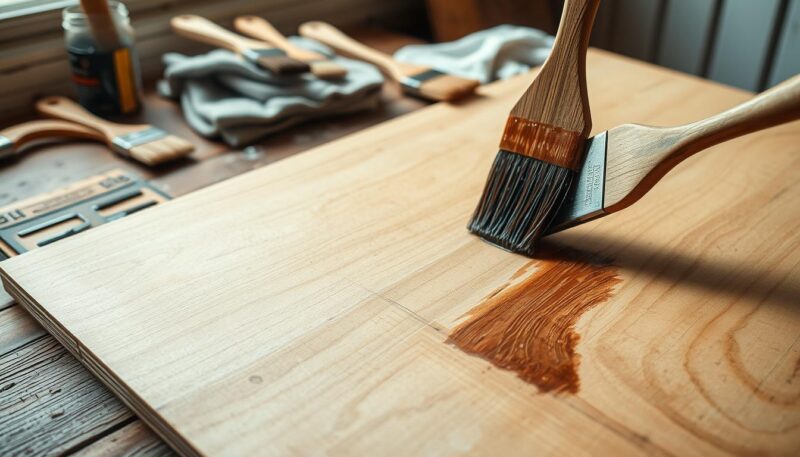Staining plywood can transform a simple sheet into a stunning piece that enhances various projects, from furniture to decorative elements. This comprehensive guide provides essential DIY tips for achieving beautiful plywood finishes. You’ll learn how to prepare the wood, select the right stain, and apply it correctly to enhance the natural beauty of staining plywood. Whether you’re a seasoned DIYer or new to woodworking, this guide will equip you with the knowledge you need to tackle your next plywood staining project with confidence.
Plywood, due to its versatility and cost-effectiveness, is growing in popularity among woodworkers. The cost for 25 sheets of 4×8 ft 15/32 3 Ply-CD-Plywood, including a $15 delivery fee, was $656. This averages to $25.64 per sheet or around $0.87 per square foot in wood materials. For a recent project, approximately 22 sheets were used to cover an area of about 750 sq ft. The additional costs for sandpaper, underlayment, construction adhesive, brad nails, and stain materials amounted to a few more dollars per square foot. Hence, it’s evident that plywood is not only affordable but also highly customizable, making it an excellent choice for many DIY projects.
Transitioning from a novice to an expert DIYer often lies in the details and preparations. Properly staining plywood begins with choosing the appropriate type of plywood and the right stain. The possibilities are limitless, whether you opt for watercolor-based, oil-based, thick gel stains, or even a DIY natural wood stain. Gel stains are particularly favored for plywood as their thicker consistency ensures an even application, especially on softer woods like pine. Applying a pre-stain wood conditioner can significantly enhance the results by ensuring uniform stain absorption, which is crucial for achieving an even finish.
The pre-staining process, however, is as important as the stain application itself. Sanding the plywood is essential to guarantee that the surface is smooth and ready to absorb the stain evenly. Notably, sanding down the sides of the boards in a previous project incurred an additional cost of $20, translating to $0.03 per sq ft. The time invested in these preparation steps, which typically amounts to about 45 minutes, sets the foundation for a successful and visually appealing staining job.
Safety is paramount when working with stains and finishes. It’s crucial to work in a well-ventilated area and use protective gear such as gloves and masks to shield yourself from potential harmful fumes. Depending on your sensitivity to fumes, you might prefer a water-based polyurethane for finishing, which is less odorous than oil-based options. One brand recommended by many DIYers is Varathane. Their Ultimate Water-Based Polyurethane is a great go-to for most projects. Additionally, if you’re pressed for time, Varathane’s Premium Fast-Dry Stain, which dries in one hour and requires only one coat, can be a lifesaver.
In conclusion, staining plywood is a rewarding and relatively cost-effective way to upgrade your projects. With proper preparation and the right materials, you can transform ordinary plywood into extraordinary pieces that showcase your craftsmanship. So, can you stain plywood? Absolutely! The key lies in following these expert DIY tips and steps to ensure a flawless finish that you can be proud of.
Preparation Techniques for Staining Plywood
When you’re gearing up for a staining project, meticulous preparation is your key to success. Knowing the right preparation techniques for stained plywood is essential to achieving a flawless finish. Here, we break down how you can prepare your plywood effectively, ensuring the stain adheres beautifully and evenly.
Choosing the Right Plywood and Stain
Selecting the appropriate plywood and stain variety is your first crucial step. Birch plywood is highly recommended due to its fine grain and affordability, available easily at home improvement stores like Home Depot. Among the types of stains, oil-based stains are favored for their deep penetration and vibrant finish, especially suitable for outdoor projects. Alternatively, gel stains can provide a more uniform appearance, albeit with limited color options. Water-based stains are another option, drying faster but potentially causing more blotchiness.
Gathering Necessary Tools and Materials
To ensure a smooth staining process, gathering the right tools and materials beforehand is indispensable. The essential tools for staining include:
- Sandpaper (80 to 220 grit)
- Orbital palm sander
- Tack cloths
- Brushes or clean, soft rags
- Safety gear (gloves, protective eyewear)
Having these tools aids in the application process and enhances the overall outcome.
Sanding and Cleaning the Surface
Sanding is a fundamental step in preparation techniques for stained plywood. Begin with a coarse sandpaper (80 grit) and gradually move to finer grits, finishing with 220 grit for a smooth surface. It’s essential to sand evenly to avoid blotchiness, particularly on Grade C and D plywoods. After sanding, use tack cloths to meticulously clean off all dust and debris, assuring an even stain application.
Applying a Wood Conditioner
Using a wood conditioner before staining can make a world of difference. It enables the stain to penetrate the wood uniformly, thereby preventing blotchy finishes. This is especially crucial for porous or softer types of plywood like birch. Apply the conditioner generously and follow the manufacturer’s drying instructions. Typically, a pre-stain conditioner helps enhance the overall finish of stained plywood.
Seal your work by understanding how to seal stained plywood effectively. Apply at least three coats of polyurethane or lacquer for maximum durability and protection against wear. Ensure each coat dries thoroughly before adding the next, working in a well-ventilated area to avoid inhaling fumes.
By following these essential preparation techniques, you set the stage for a successful staining project, regardless of the types of stains or plywood used. This ensures a long-lasting, visually appealing finish that showcases the natural beauty of the wood.
| Type of Plywood | Recommended Stain | Sanding Grit | Drying Time | Topcoat Finish |
|---|---|---|---|---|
| Birch Plywood | Oil-based | 80-220 | 12 hours | Polyurethane |
| Pine Plywood | Water-based | 100-150 | 24 hours | Varnish |
| Oak Plywood | Gel Stain | 120-180 | 18 hours | Lacquer |
Can You Stain Plywood?
Absolutely, you can stain plywood with the right preparation and techniques, creating stunning indoor and outdoor projects. Choosing between outdoor vs. indoor plywood is crucial; outdoor varieties often require more robust stains and sealants to withstand the elements. Conversely, indoor plywood offers a broader range of options for color and finish, allowing you to perfect your project ideas.
Preparation is key to a successful staining job. To avoid common mistakes, start by sanding the plywood thoroughly to eliminate any glue residue or rough patches. Using a TSP cleaner will ensure the surface is clean and ready to absorb the stain evenly. Applying a wood conditioner before staining can prevent blotchy results, especially in softwood plywoods. For better coverage, consider applying two coats of stain, as this can rectify patchy areas and provide a richer finish.
Maintenance of stained plywood is vital to preserving its appearance and integrity. Regular check-ups and reapplications of sealant or a topcoat are recommended to protect against wear and tear. This becomes particularly pertinent in outdoor projects where the wood is exposed to varying weather conditions. The deck rebuild on a tight budget, for instance, could benefit significantly from periodic maintenance to ensure longevity.
Staining plywood not only revamps its look but also offers a cost-effective solution compared to other methods like tiling. Many DIY enthusiasts have shared their positive experiences, transforming their basement floors and porches by staining plywood after removing old carpet and dealing with glue residues. By carefully selecting and applying the appropriate stain, such as Behr’s Cordovan Brown, you can achieve stunning and durable finishes, turning everyday plywood into something extraordinary.

